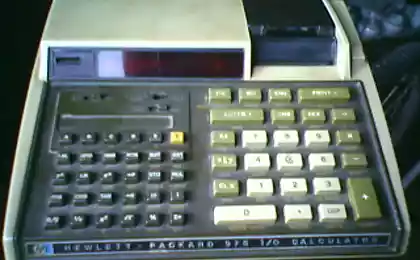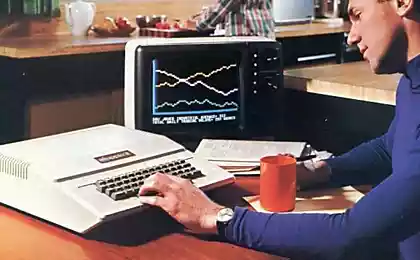1528
The history of things
Every day our lives are introducing more and more new design, fashion Soup and intelligent robots.
Thus, we completely forget about devices of the past centuries.
Of course, but why do we need them!
Let us remember them at least for common development.
In this article we have compiled the most worthy samples of counting machines for the past 250 years.
The starting point of the story - the 1786-th year and the Difference Engine Helfrika Johann von Muller.
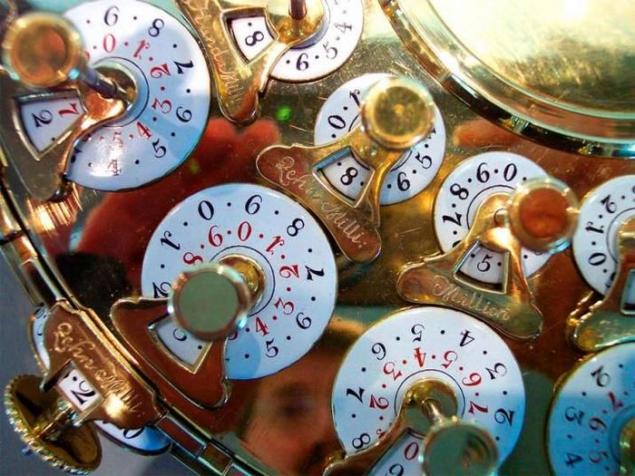
The name of Johann Muller ph (1746-1830) is almost unknown to our contemporaries, but his achievements in the development of German engineering and technology can not be overestimated. In addition to the difference engine, which he created while serving in the army of Hesse, Muller has also designed its own sundial, air pump and an air gun, the ignition mirror and other useful tools.
The basis of counting device was taken stepper reel and Leibniz difference engine, previously designed by German engineer Philippe Khan. Apparatus Mueller was much larger (28.5 cm in diameter, height of 9.5 cm and a weight of 15.4 kg) and had the appearance of a round box with a lever in the center and dials on the perimeter. The device is operated with numeric digits and fourteen were suitable for settlement in nedesyatirichnoy notation.
The appearance of the device resembles a Victorian music box, rather than the usual calculator.
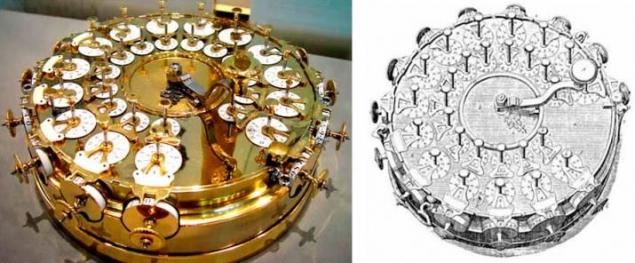
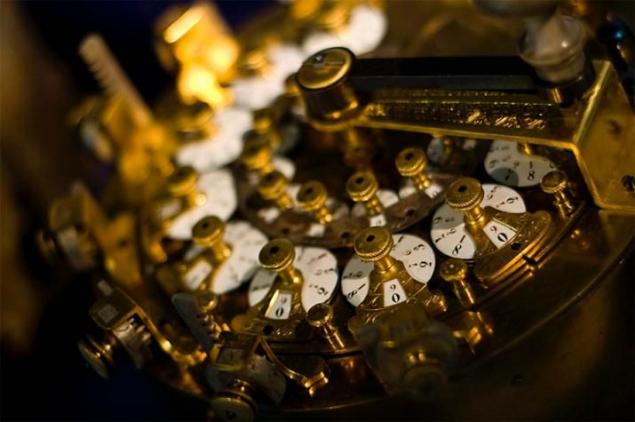
Another rare instance (balm for the heart for lovers of style steam-punk) - aritmometr WT Odhner Vilgodta Theophile Odhner presented to the public in 1893. Odhner was Swedish by nationality, but his engineering studies and business conducted in St. Petersburg.

This is not a gramophone record and the Jazz Age Calculator: British firm Adall produced such exquisite counting machines in the early 20-ies.
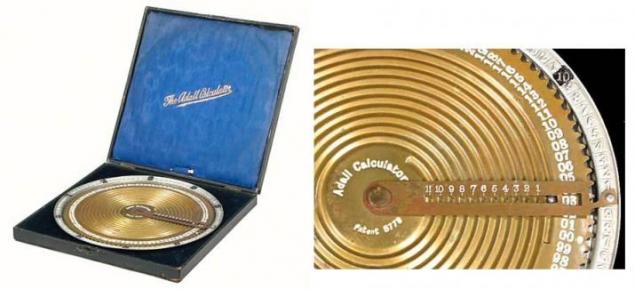
Another example of English design: single-line arithmometer Adder (left), first went on sale in 1902. To his right - light and compact enough arithmometer Comptator, produced in Germany in the 20s.
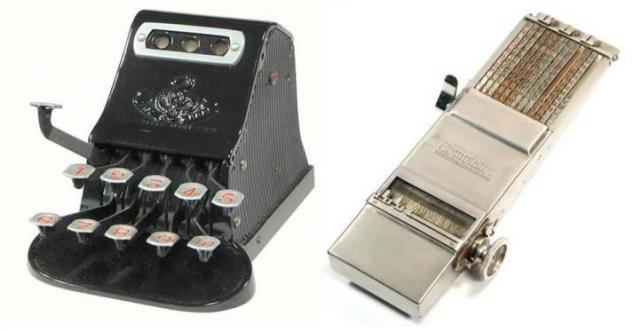
Answer American industrialists - "High summing car Monroe», produces over twenty years.
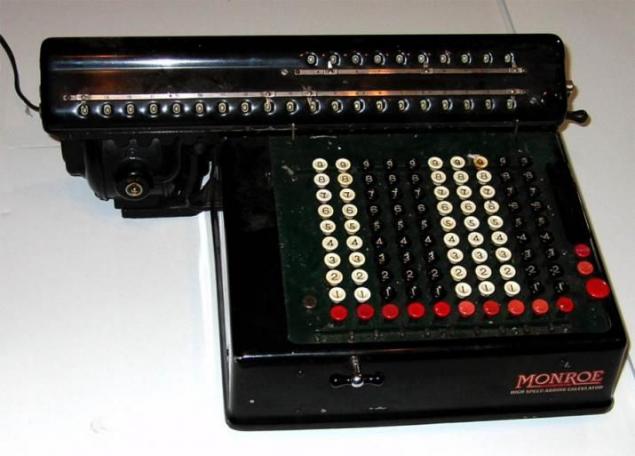
By today's standards, the rate of payments was terribly slow, but everything is relative: the war, the counting machines Monroe had a prestigious and expensive office device. Advertising in the magazine LIFE unit in the 40s:

Pocket calculator mid-forties. First Baby Calculator was released in Chicago in 1929, and its compact size was indisputable advantage in the eyes of users.
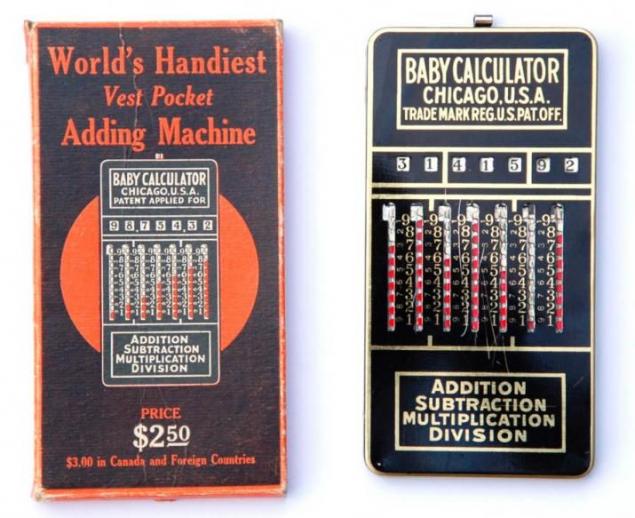
Remington Rand Company is considered one of the founders of the market "business machines" in the United States. Originally produced Remington typewriters, and a subsidiary, produces calculators, it was founded in the late 20s. This model - Remington Rand Calculator 73R produced in the fifties and positioned in advertising as a "weapon against time».
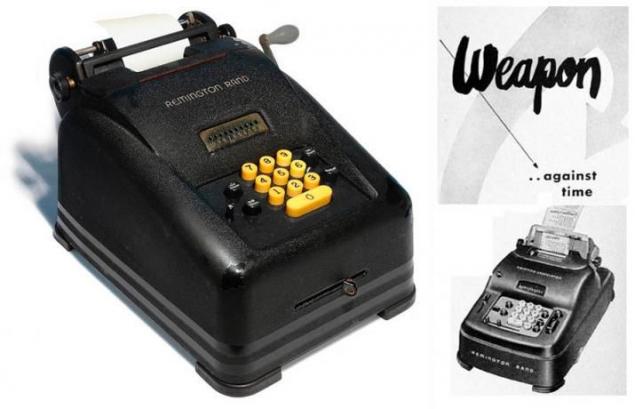
Exactus - rare exhibits and evidence of the global historical change. It was manufactured in the UK and there only had the use, because it was designed for the calculation of the old system of foreign exchange of the country, which was in force before the reform of 1971. After the transition to the decimal system such calculators lost practical value.
To the right of the British calculator - Addiator mechanical adding machine made in Germany.
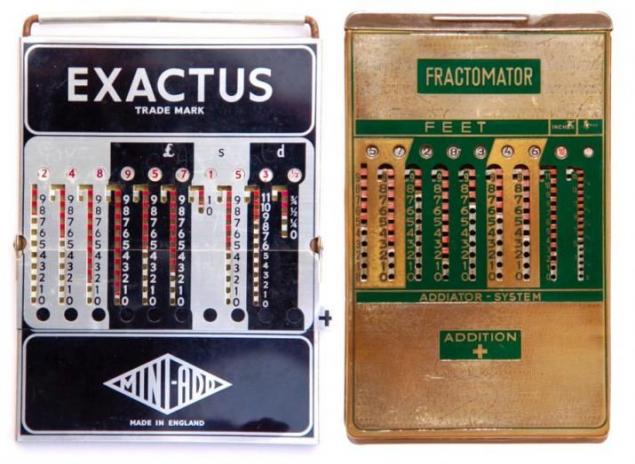
Soviet replica Addiatora called "Counting Machine Progress».
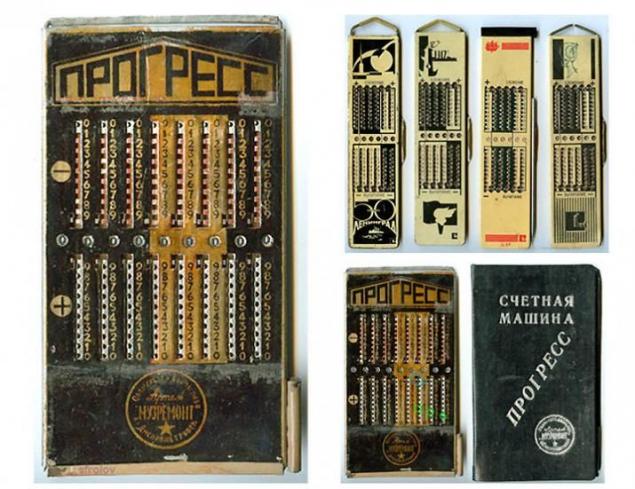
Even more famous in Britain were counting machines brand Burroughs. These devices were designed to calculate in the old currency.

Compact, portable Burroughs Series 5 released in 1957, the year differed rounded forms.
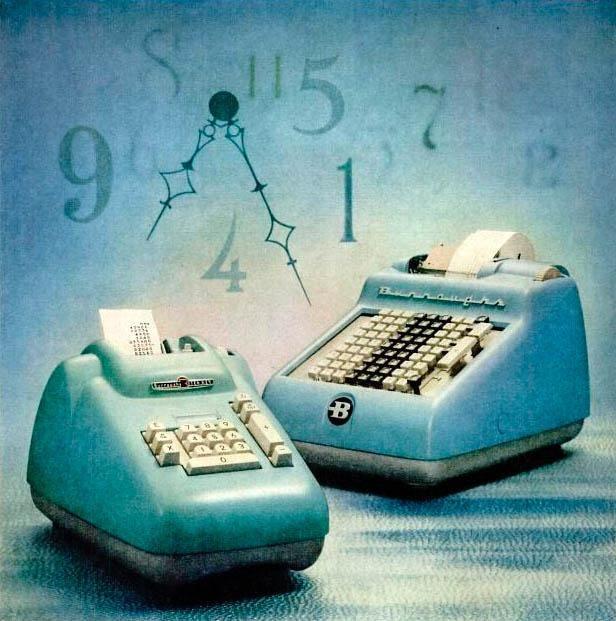
And this is - a mechanical adding machine "Felix-M" - a direct descendant of aritmometra Odhner.
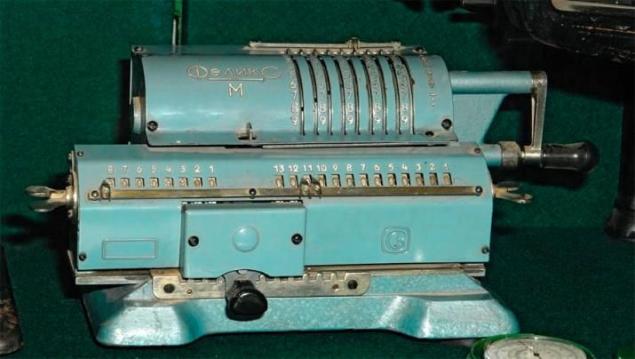
Sample design early sixties - mechanical calculator Facit-13.
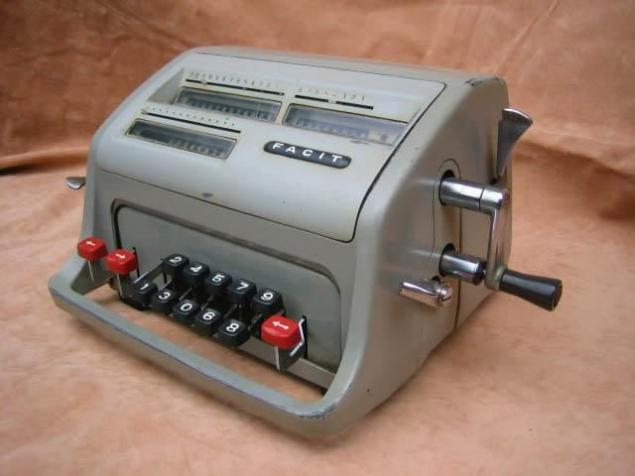
His peers - electric desktop calculator Victor 3900 is significantly inferior in design.
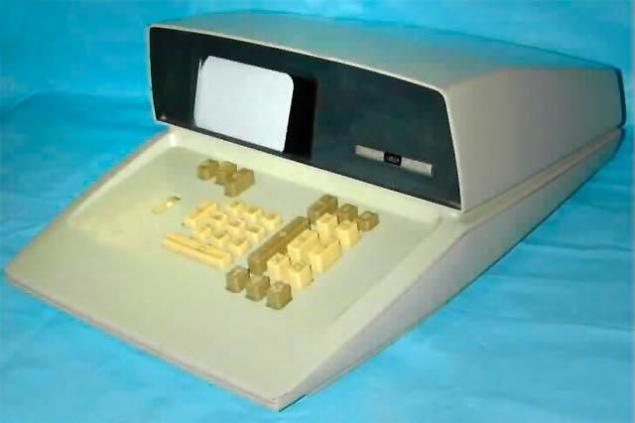
In the seventies in the USSR it was time to "Electronics" (left). Electric counting machines of the brand were in public institutions throughout the country. Right - Bulgarian counting machine Elka 103.

Laconic industrial design and Futurism (in what was then his understanding) - the main signs of the style of the seventies. The most common counting machines of the time: Cannon Canola 1614P (top left), Compucorp 425 G (top right), Casio 121-E (bottom left), Rockwell 940. Soviet "Elektronika" with a huge delay and with great difficulty, she studied the achievements of Japanese designers .
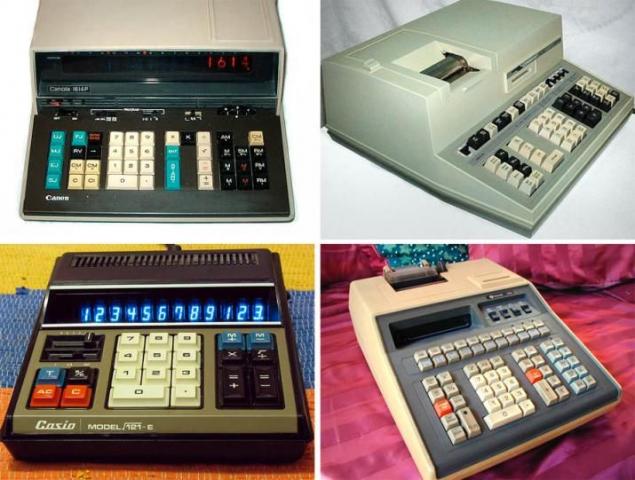
The first signs of compactness and versatility - as presently defined - Calculator, released in the late seventies by Texas Instruments ...
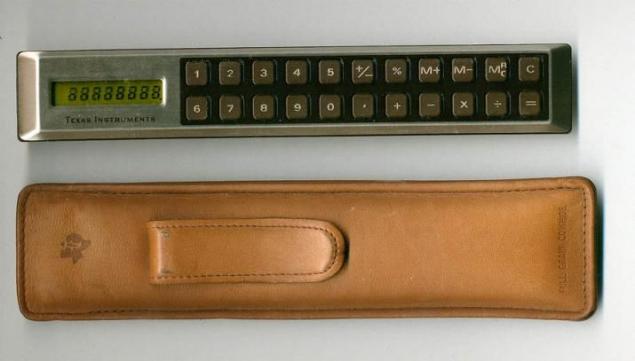
... And Calcu-Pen - a pen, calculator:
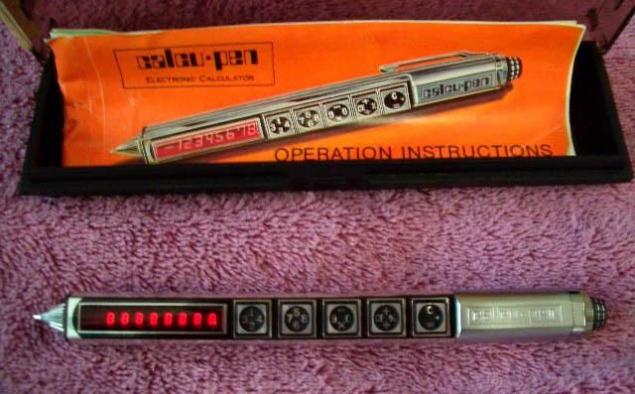
The only reason to wear a calculator on the wrist instead of the clock was the fear of losing counting machine in pile of papers - a special device beauty did not shine:

Well, what happened next - you know yourself. It is likely that even our grandchildren will not be able to explain how the functioning of counting machines, which can be seen in the hands of the boy in this daguerreotype. But time has passed - nothing at all ...
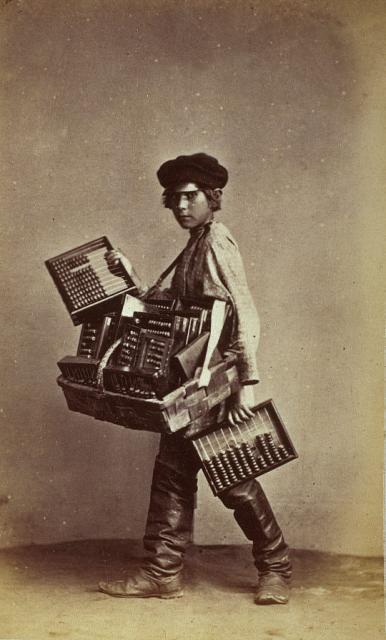
Source: podkofeek.ru
Thus, we completely forget about devices of the past centuries.
Of course, but why do we need them!
Let us remember them at least for common development.
In this article we have compiled the most worthy samples of counting machines for the past 250 years.
The starting point of the story - the 1786-th year and the Difference Engine Helfrika Johann von Muller.

The name of Johann Muller ph (1746-1830) is almost unknown to our contemporaries, but his achievements in the development of German engineering and technology can not be overestimated. In addition to the difference engine, which he created while serving in the army of Hesse, Muller has also designed its own sundial, air pump and an air gun, the ignition mirror and other useful tools.
The basis of counting device was taken stepper reel and Leibniz difference engine, previously designed by German engineer Philippe Khan. Apparatus Mueller was much larger (28.5 cm in diameter, height of 9.5 cm and a weight of 15.4 kg) and had the appearance of a round box with a lever in the center and dials on the perimeter. The device is operated with numeric digits and fourteen were suitable for settlement in nedesyatirichnoy notation.
The appearance of the device resembles a Victorian music box, rather than the usual calculator.


Another rare instance (balm for the heart for lovers of style steam-punk) - aritmometr WT Odhner Vilgodta Theophile Odhner presented to the public in 1893. Odhner was Swedish by nationality, but his engineering studies and business conducted in St. Petersburg.

This is not a gramophone record and the Jazz Age Calculator: British firm Adall produced such exquisite counting machines in the early 20-ies.

Another example of English design: single-line arithmometer Adder (left), first went on sale in 1902. To his right - light and compact enough arithmometer Comptator, produced in Germany in the 20s.

Answer American industrialists - "High summing car Monroe», produces over twenty years.

By today's standards, the rate of payments was terribly slow, but everything is relative: the war, the counting machines Monroe had a prestigious and expensive office device. Advertising in the magazine LIFE unit in the 40s:

Pocket calculator mid-forties. First Baby Calculator was released in Chicago in 1929, and its compact size was indisputable advantage in the eyes of users.

Remington Rand Company is considered one of the founders of the market "business machines" in the United States. Originally produced Remington typewriters, and a subsidiary, produces calculators, it was founded in the late 20s. This model - Remington Rand Calculator 73R produced in the fifties and positioned in advertising as a "weapon against time».

Exactus - rare exhibits and evidence of the global historical change. It was manufactured in the UK and there only had the use, because it was designed for the calculation of the old system of foreign exchange of the country, which was in force before the reform of 1971. After the transition to the decimal system such calculators lost practical value.
To the right of the British calculator - Addiator mechanical adding machine made in Germany.

Soviet replica Addiatora called "Counting Machine Progress».

Even more famous in Britain were counting machines brand Burroughs. These devices were designed to calculate in the old currency.

Compact, portable Burroughs Series 5 released in 1957, the year differed rounded forms.

And this is - a mechanical adding machine "Felix-M" - a direct descendant of aritmometra Odhner.

Sample design early sixties - mechanical calculator Facit-13.

His peers - electric desktop calculator Victor 3900 is significantly inferior in design.

In the seventies in the USSR it was time to "Electronics" (left). Electric counting machines of the brand were in public institutions throughout the country. Right - Bulgarian counting machine Elka 103.

Laconic industrial design and Futurism (in what was then his understanding) - the main signs of the style of the seventies. The most common counting machines of the time: Cannon Canola 1614P (top left), Compucorp 425 G (top right), Casio 121-E (bottom left), Rockwell 940. Soviet "Elektronika" with a huge delay and with great difficulty, she studied the achievements of Japanese designers .

The first signs of compactness and versatility - as presently defined - Calculator, released in the late seventies by Texas Instruments ...

... And Calcu-Pen - a pen, calculator:

The only reason to wear a calculator on the wrist instead of the clock was the fear of losing counting machine in pile of papers - a special device beauty did not shine:

Well, what happened next - you know yourself. It is likely that even our grandchildren will not be able to explain how the functioning of counting machines, which can be seen in the hands of the boy in this daguerreotype. But time has passed - nothing at all ...

Source: podkofeek.ru







